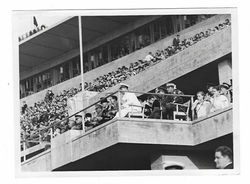
Mind Over Milliseconds - Mental Resilience At The Miami Grand Prix

By Chandrally Mahajan, Chief Healthcare Correspondent
Special Coverage from the 2025 Miami GP
May 9, 2025
At the 2025 Miami Grand Prix, precision was everything—and still, it wasn’t always enough. During Day 1 qualifying practice, two drivers clocked identical lap times down to the thousandth of a second, momentarily tying for first place. For a brief, electrifying instant, they were on top—until another two racers delivered laps just milliseconds faster, coming in close together and knocking their competitors down to third and fourth. The ruthless reshuffling continued, etched onto the leaderboard in cold, unforgiving numbers: 1:28.0, then +0.3, +0.5, and so on. No one made a mistake. They were simply... outpaced.
Watching it unfold doesn’t feel like failure. It feels rather like emotional whiplash—like putting your entire soul into something, only to watch it be outrun by the tiniest margin imaginable.
Mental Endurance at High Speeds
When things go wrong, F1 drivers don’t have time to get upset or dwell. They use short phrases or breathing techniques to keep going. Their brains learn to compartmentalize by blocking out fear and staying calm under pressure. Moreover, they focus on the next lap. This ability to reset and move forward helps them stay confident and not spiral into self-blame. That’s what mental endurance looks like—staying focused, even when pressure mounts.
The Neuroscience of High-Speed Decision-Making
Formula 1 drivers operate under immense cognitive demand. Decisions are made at over 200 mph, where delays of even 100 milliseconds can cost critical positions. Neurologically, this kind of performance is powered by lightning-fast sensorimotor processing, intense prefrontal cortex regulation, and deeply rehearsed muscle memory. Drivers must suppress panic responses while staying hyper-attuned to micro-adjustments in grip, track conditions, and physical mechanics—all while strategizing positionally.
The Calm Before the Storm
The day began with foreshadowing. A red flag late in practice brought the session to a halt after a driver clipped the wall near Turn 1. The contact was minor, but the symbolism wasn’t. This track doesn’t tolerate hesitation. In F1, the margin of error is so slim, even a whisper of overcorrection can end your day.
Teamwork in the Pit
Pit stops happen in under three seconds. The crews resemble a trauma surgical unit more than a garage team. Each movement is rehearsed, choreographed, and timed to perfection. They embody “group flow,” a psychological state where communication becomes intuitive and roles dissolve into seamless execution. Any hesitation or ego can derail performance. It’s not just about speed; it’s about working as a unit.
Fandom, Identity, and the Psychology of Spectating
F1 spectators don’t just watch—they feel. The crowd surges with adrenaline, anticipation, and tribal loyalty. Wearing team colors or chanting a favorite driver’s name isn’t superficial, it’s a form of identity affirmation. Psychologically, sports spectatorship provides a sense of belonging, catharsis, and even physiological changes due to intense emotional investment—mimicking the highs and lows of direct competition.
Staying Calm in Chaos
One veteran incident marshal, who has worked high-risk posts at international circuits including last year’s Mexican Grand Prix, recalled a moment where they narrowly avoided serious injury during a chaotic race start. Ducking quickly when a car launched off the line unexpectedly, this story highlights the importance of staying calm but vigilant. These workers on the sidelines are just as mentally strong as the drivers on the track.
What This Teaches Us
Not everyone is a race car driver. But we all know what it’s like to work hard and still not come out on top. We all have moments where we think we’ve won—only to see things change at the last second.
This sport quickly showed me that doing your best doesn’t always mean winning. What matters is staying steady, adapting fast, and continuing forward. This was demonstrated by the F1 drivers when they returned later that day for the sprint qualifying.
SQ1: Echoes of Earlier Chaos
With just over two minutes left in the first Sprint Qualifying (SQ1) race, that same, rare phenomenon unfolded as three drivers settled in with matching lap times, locked in a dead heat at the top of the board: Lando Norris, Max Verstappen, and Kimi Antonelli.
It was déjà vu.
The leaderboard froze. Fans held their breath. And just like in practice, it came down to a final push. George Russell delivered—a lap of 1:27.6 that broke the tie and sent the rest tumbling.
SQ2: Precision Under Pressure
SQ2 saw tension rise another level. With a 1:27.3, Oscar Piastri lit up the board early, followed closely by Norris and Antonelli—again separated by mere tenths. Verstappen and Russell hovered in the mix, while Hamilton edged in at tenth with a solid final effort. In the closing seconds, Norris took the top spot. But it wasn’t by domination, it was by 0.1 seconds (s). The heartbreak wasn’t theatrical, it was clinical. It lived in the timing data, not yet in the faces of the audience.
SQ3: The Final Push
The final session delivered everything fans could’ve hoped for. Russell opened strong, posting a 1:26.7. Verstappen trailed by just 0.2s. Albon shocked many by sliding into third—momentarily.
And then came Kimi Antonelli.
The rookie driver, cool under pressure, nailed his lap: 1:26.4. Clean, fast, and unfazed with a staggering time that redefined the grid. Piastri came within 0.045s. Norris followed at 0.1s.
Final Top 10 Qualifying Results: Antonelli – 1:26.4, Piastri – +0.0s, Norris – +0.1, Verstappen – +0.2, Russell – +0.3, Leclerc – +0.3, Hamilton – +0.5, Albon – +0.7, Hadjar – +1.0, Alonso – +1.3
What It Means
The first Italian to take the pole 1 position in Miami didn’t do it with luck. He did it with precision and poise. This is a tremendous advantage as it determines the starting grid on race day.
Antonelli showed that pressure doesn’t break everyone—sometimes, it sharpens them. And that’s the story of this qualifying day: the ones who kept calm, adapted fast, and didn’t flinch were the ones who rose.
This wasn’t chaos. It was evolution. And for anyone watching—whether you’re a driver, a student, or someone just trying to push through the unknown—it was inspiring.
Day 3: Final Race
Though Antonelli had the P1 position, he was unable to stay in the top 5 as the race took a surprising turn. We saw Norris rise quickly to the top, but suddenly he was eclipsed by none other than his McLaren teammate, Piastri with a smooth and flawless 1:28.5.
Final Top 10 Race Results: Piastri – 1:28.5, Norris – +4.6s, Russell – +37.6, Verstappen – +39.9, Albon – +48.0, Antonelli – +55.5, Leclerc – +57.0, Hamilton – +60.1, Sainz – +60.5, Tsunoda – +74.4
When Effort Isn’t Enough
Formula 1 isn’t just about speed. It’s about heartbreak, recalibration, and the kind of focus that outlasts disappointment. You can be flawless—and still get bumped. You can hit the exact same mark as the person ahead of you—and still land behind them.
That’s not just racing. That’s life.
The real lesson echoes mental flexibility. Can you stay calm while the rankings shift? Can you push again when it feels like the moment passed? Can you find value in the effort even when the result falls short?
As a medical student applying to psychiatry, what struck me most wasn’t just the speed, it was the silence as drivers exited their cars. The deep, practiced calm each driver shows after heartbreak. It mirrors the same discipline we’re taught in medicine: show up, stay steady, and keep going—even when you don’t know the outcome. That’s the lesson racing gives back to the rest of us. Focus only on what you can control: not the clock or the conditions, but your actions and most importantly, your mind.
In a world ruled by uncertainty and time is unforgiving, resilience is the only way to keep driving forward. Mind over milliseconds isn’t just a racing principle. It’s a way to live.
That’s it for now. Signing off!
Contact Me
Want to learn more about what’s out there in the world of medicine and human behavior? Put in a request at: brightenMDcare@gmail.com and I’ll do my best to report back about the latest trends, evidence-backed observations, and health-related takeaways. Please note that any medical questions must be asked to your Healthcare Provider and I am simply stating evidence-based findings and personal opinions. This is not to be interpreted as professional advice nor am I making any personal recommendations for your own care. Wishing you the best of health. Thank you!
















































